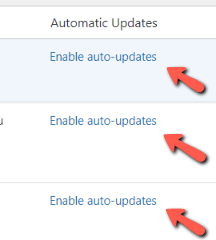When administrating WordPress websites, you can opt for the plugins/themes, and even WordPress to update automatically.
What are automatic updates?
When the developer team pushes a bug or security fix, or even a new feature or version of their product/plugin/theme, an update will become available, so that you can benefit from that fix or the new features.
Updates can be done manually or automatically. A manual update will require you to check if there are any updates, and, if available, to go through the process of updating it.
Check out this article if you want to see how you can safely update Thrive Themes products.
Unless it’s a major update, WordPress will automatically update by default.
For the rest of the plugins and themes that you’ve installed on your sites (whether they are from Thrive Themes, or other products), you will have to manually choose the “Enable automatic updates” if you want the option activated:

As a site owner, you can decide if you want to enable this option, and, if you do, for which plugins and themes it should be enabled. You can turn on the auto-updates for all products, only a few of them, or none.
How does this option work?
The way WordPress handles updates is by executing the wp-cron function twice every day. If the function finds any available updates for plugins or themes, whether those are minor fixes or larger scale feature updates, WordPress will automatically download and install the update.
Of course, this process will only work for the products, plugins and themes for which you’ve enabled the auto-updates option.
Should I enable automatic updates on my site?
Well, the answer to this question depends on you, what you are looking to achieve and what type of website you are managing.
You should make a responsible and informed decision when it comes to auto-updates, which is why we’ve decided to create this article.
Automatic updates are usually a good feature to use if you, as a site administrator, do not wish to have any hustle related to manually updating the plugins from your site. It can really be a timesaver, especially if you have multiple plugins or run multiple websites.
However, there are, indeed, some situations that you might have to consider before enabling auto-updates:
→ Multiple releases within a few hours
Especially in the case of bug/security fixes, sometimes it might happen that the developer team pushes multiple product releases/versions in the timeframe of a few hours.
In this case, your website might have to suffer, as that usually happens when there are unexpected issues in the initial release. This may result in your website experiencing issues or even crashing.
→ Multiple auto-updates running at the same time might fail
When the wp_cron function triggers multiple updates at the same time, the server resources may be overloaded, and that can result in some of the updates crashing.
If an automatic update fails, the website is prone to experiencing a fatal error message, and that can lead to you having to uninstall/reinstall some of your plugins. Your website might even go into maintenance mode without you even noticing.
→ You will not know exactly what changed and when
Some of the releases come with important changes. If you enable automatic updates, you might stumble upon things on your website that don’t work the same way as you’ve remembered.
A great way to keep a track of the changes that come with each release is by reading the developer changelogs. The Thrive Themes changelog can be found here.
→ Major updates can come with compatibility problems
We often talk about plugin or theme conflicts on your site. A major release means that big changes were added to the code or database, and that can introduce unexpected issues or conflicts.
In the case of major releases or updates, it is advised to wait for a while, just to ensure that the release is stable. Enabling auto-updates will not give you this opportunity.
The benefits of enabling automatic updates
On the other hand, automatic updates have their advantages, as well. As mentioned above, if you run multiple plugins or themes on your site, enabling automatic updates will save you time.
If you are just looking for a way to make sure that your site is always updated to the newest versions of each product, enabling the auto-updates is for sure the solution for you.
Moreover, you can choose the plugins/themes for which the automatic updates should be performed, so you can really customize the process to your needs.
To sum everything up, it is important to remember that whether you should enable automatic updates on your website or not, really depends on what type of site you are managing.
For small-scaled websites, you may be willing to risk a ‘bad’ update in favour of the advantages this feature brings. Even if something goes wrong, the impact on the users will not be major.
But, if you run an online shop or just a larger online business, you should always consider the risks that come with your website being down for a while, as well as the customer experience and overall happiness and all those factors that might have a big impact on your business. The stakes will be higher if the website crashes.
Either way, auto-updates enabled or not, you should make sure you keep a backup of your site at all times. If you are not sure how to do that, please check out our article here.
Hopefully, this article was useful to you. Don’t forget to check out the rest of the articles and tutorials from our knowledge base, as well.